
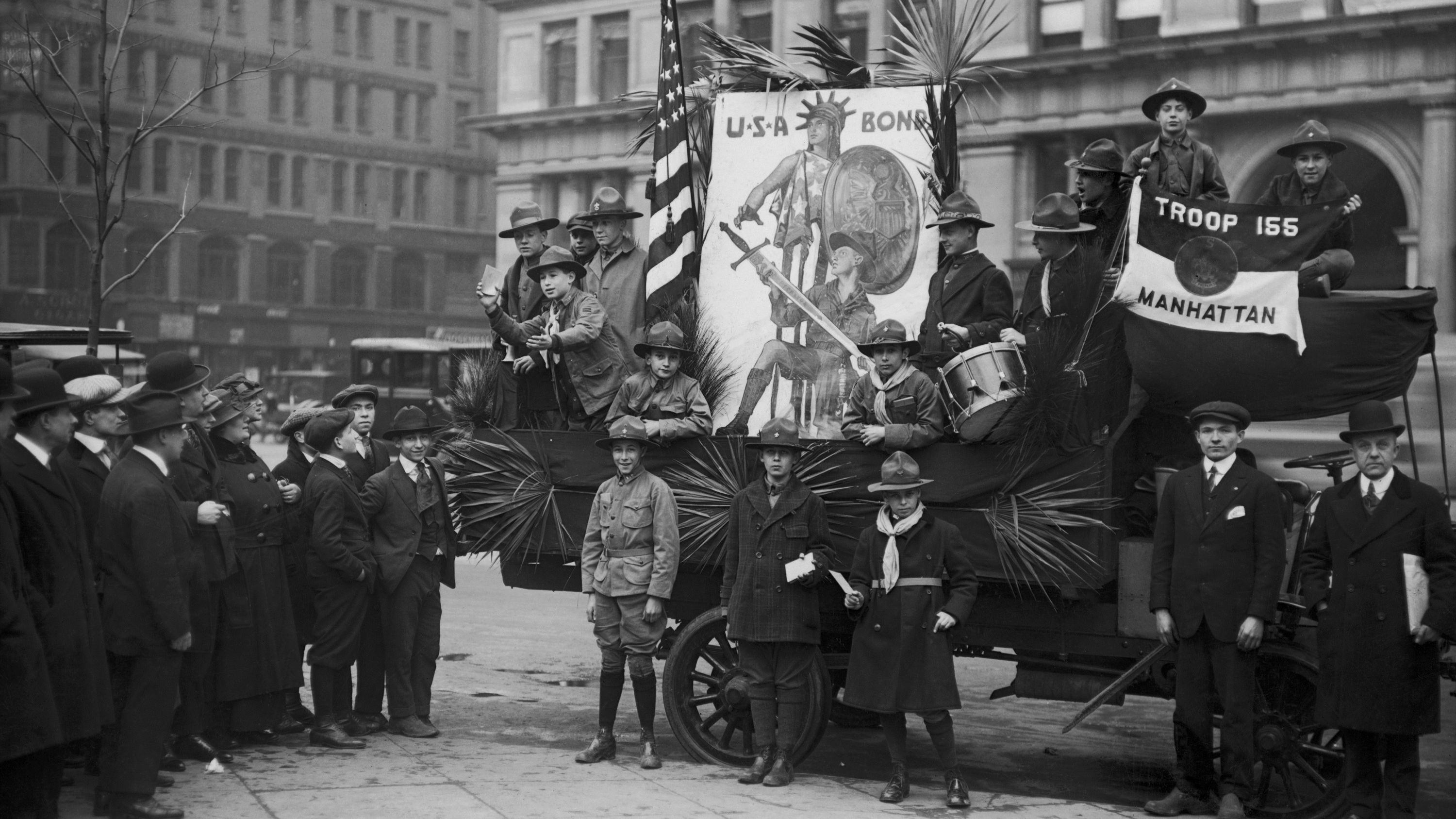
“Boy Scouts promoting war bonds.” Getty Images, 1918.
The CPI helped raise $17 billion in US war and post-war funding with its wildly successful Liberty Bonds advertising campaign. "Treasury sold large denomination bonds to financial institutions and bonds with face values as low as $50 directly to individuals. In December 1917, Treasury offered War Savings Certificates and Stamps to entice low-
income Americans to invest in the war effort. The 25 cent stamps could be collected in books and exchanged for $5 savings certificates; the lowest
denomination offered." - "Liberty Bond," Museum of American Finance (2021) [1]
"The propaganda campaign was essential, not just to sell bonds, but to sell the war…the greatest advertising effort ever conducted…11,000 billboards and streetcar ads in 3,200 cities…60,000 women were recruited to sell bonds…seven million fliers on Liberty Day…mailed two million information sheets to farm women…'enthusiastic' librarians inserted four-and-one-half million Liberty Loan reminder cards in public library books in 1,500 libraries…Charlie Chaplin, Mary Pickford, and Douglas Fairbanks, certainly among the most famous personalities in America, toured the country holding bond rallies attended by thousands." - "Liberty Bonds," Federal Reserve History (5 Dec. 2015) [2]
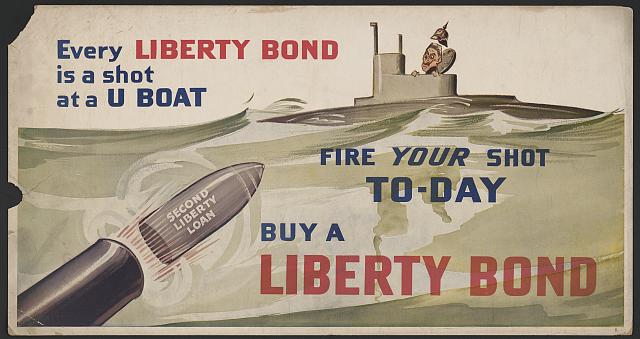
“Every Liberty Bond is a shot at a U boat--Fire your shot today--Buy a Liberty Bond.” Library of Congress, 1918.
“Help Uncle Sam Stamp Out the Kaiser! 3rd Liberty Loan. Buy U. S. Gov’t Bonds.” Boston Athenaeum Digital Collection, 1918.
“Remember your first thrill of American liberty Your duty - Buy United States government bonds--2nd Liberty Loan of 1917.” Library of Congress, 1917.
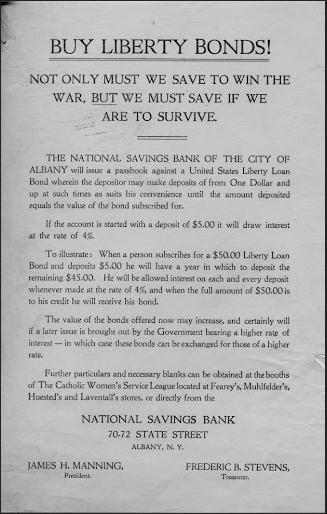
“Buy Liberty Bonds, World War I, c. 1917.” New York State Archives, 1917.
Liberty Bond sales helped financially educate underserved populations, and were the first investments many Americans had made. They also had lasting effects on the US financial system:
"Financial firms learned how to mass market securities, and middle-class Americans became accustomed to putting their savings to work outside the corner bank. After the war, those who had subscribed to Liberty Bonds were more likely to invest in stocks and bonds, advancing the development of US capital markets."
- "WWI Liberty Bonds and the Culture of Investing," National Bureau of Economic Research
(Nov. 2020) [3]
The campaign implied people were unpatriotic if they did not buy bonds. People faced strong pressure to invest. Ethnic Germans in particular faced retaliation if they didn’t.
"Citizens began organizing themselves into 'patriotic' or 'vigilance' committees to try and convince these 'slackers' to change their minds…Vigilantes visited [German] Mennonite who did not contribute to the Red Cross or buy bonds, and they "confiscated" the farmers’ cattle to sell for the war effort. Mennonite churches that refused to display the American flag had their doors and walls painted yellow." - Sara J. Keckeisen, "The Cost of Conscience Part 1: Coming of the Night Riders" [4]
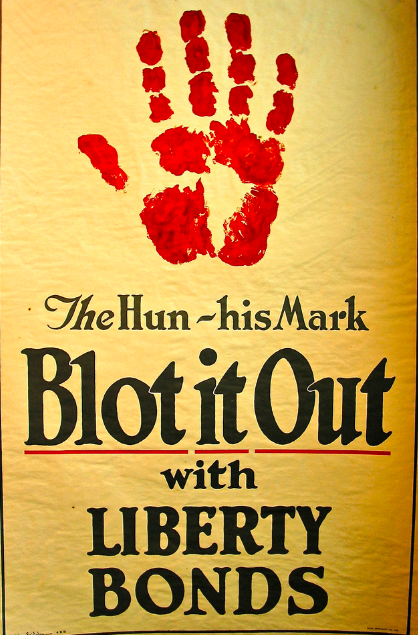
"The Hun - His mark - Blot it out with Liberty Bonds.” Library of Congress, 1918.
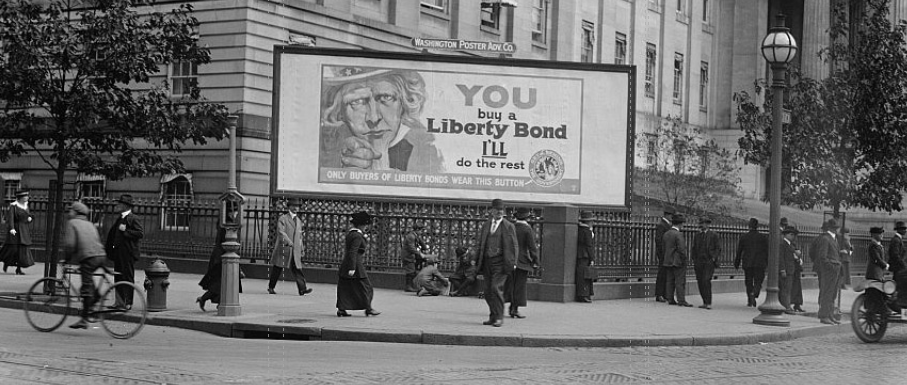
“WWI Commemoration Task Force: The Liberty Loan Drives in Arlington.” Arlington Virginia Advisory Groups and Commissions, ca. 1917-1918.
Header image: "1918 $50 4.25% First Liberty Loan," Joe I. Herbstman Memorial Collection of American Finance, 1918.
[1] “Liberty Bond.” Museum of American Finance, an Affiliate of the Smithsonian Institution, 2021.
[2] “Liberty Bonds.” Federal Reserve History, 4 Dec. 2015.
[3] “WWI Liberty Bonds and the Culture of Investing.” National Bureau of Economic Research, Issue: No. 11, Nov. 2020.
[4] Keckeisen, Sara J. “The Cost of Conscience Part 1: Coming of the Night Riders.” Kansas Heritage, Summer 2004, vol. 12, no. 2. Kansas Historical Society.